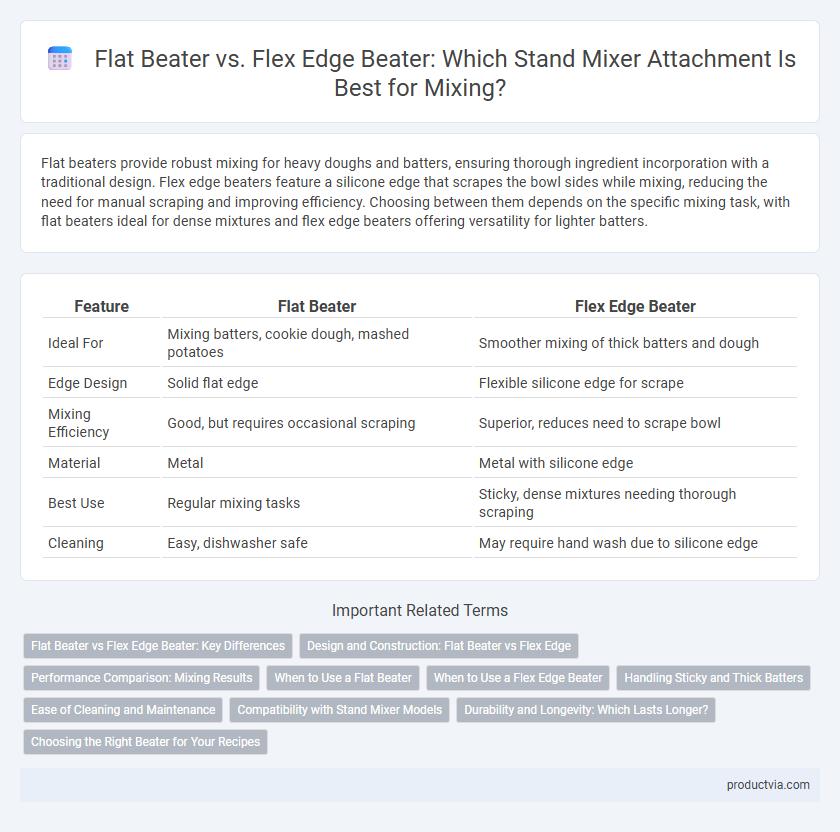Flat beaters provide robust mixing for heavy doughs and batters, ensuring thorough ingredient incorporation with a traditional design. Flex edge beaters feature a silicone edge that scrapes the bowl sides while mixing, reducing the need for manual scraping and improving efficiency. Choosing between them depends on the specific mixing task, with flat beaters ideal for dense mixtures and flex edge beaters offering versatility for lighter batters.
Table of Comparison
| Feature | Flat Beater | Flex Edge Beater |
|---|---|---|
| Ideal For | Mixing batters, cookie dough, mashed potatoes | Smoother mixing of thick batters and dough |
| Edge Design | Solid flat edge | Flexible silicone edge for scrape |
| Mixing Efficiency | Good, but requires occasional scraping | Superior, reduces need to scrape bowl |
| Material | Metal | Metal with silicone edge |
| Best Use | Regular mixing tasks | Sticky, dense mixtures needing thorough scraping |
| Cleaning | Easy, dishwasher safe | May require hand wash due to silicone edge |
Flat Beater vs Flex Edge Beater: Key Differences
The Flat Beater features a solid, flat design ideal for mixing medium-to-heavy batters, cookie dough, and mashed potatoes, ensuring thorough blending without over-aeration. The Flex Edge Beater incorporates a flexible silicone edge that scrapes bowl sides during mixing, reducing the need for manual scraping and improving ingredient incorporation. Choosing between the two hinges on the type of recipe and efficiency preference, with the Flex Edge offering enhanced scraping for sticky or dense mixtures compared to the traditional Flat Beater.
Design and Construction: Flat Beater vs Flex Edge
The flat beater features a solid, rigid design with a flat paddle shape ideal for thoroughly mixing medium to heavy batters, ensuring consistent texture without scraping the bowl's edges. In contrast, the flex edge beater incorporates a flexible silicone edge that conforms to the bowl, effectively scraping sides and bottom to reduce mixing time and eliminate the need for manual bowl scraping. Both attachments are typically constructed from durable metal alloy, but the flex edge's silicone rim enhances efficiency by combining mixing and scraping in a single motion.
Performance Comparison: Mixing Results
The flat beater delivers consistent mixing performance for heavier, denser batters, achieving uniform results in doughs, cookie mixes, and cake batters with minimal manual scraping. In contrast, the flex edge beater incorporates flexible silicone edges that scrape the bowl during mixing, reducing the need for stopping and improving ingredient incorporation for smoother, more even mixtures. Performance comparisons show the flex edge beater excels in minimizing mixing time and reducing residue buildup, resulting in more efficient and thorough blending of ingredients.
When to Use a Flat Beater
A flat beater is ideal for mixing medium to heavy mixtures such as cake batter, cookie dough, and mashed potatoes, providing thorough and even blending without over-aeration. It excels in tasks requiring consistent incorporation of ingredients, ensuring smooth textures and proper mixing of dense or stiff substances. Choosing a flat beater enhances efficiency when working with batters and doughs that do not need whipping or folding.
When to Use a Flex Edge Beater
The Flex Edge Beater is ideal for recipes requiring thorough scraping of bowl sides, such as thick batters, frostings, and cookie doughs, ensuring even mixing without manual scraping. Its silicone edges efficiently incorporate ingredients, reducing mixing time and improving texture consistency. Choose a Flex Edge Beater when working with sticky or dense mixtures to achieve smooth, uniform results.
Handling Sticky and Thick Batters
The flat beater excels at mixing thick and dense batters, efficiently combining ingredients without incorporating excess air, making it ideal for cookie doughs and bread batters. The flex edge beater features a flexible silicone edge that scrapes the bowl's sides continuously, minimizing the need to stop and scrape manually, which improves handling of sticky batters like cake and frosting. Both attachments enhance mixing performance, but the flex edge beater offers superior efficiency for sticky and thick mixtures by reducing batter residue and ensuring consistent incorporation.
Ease of Cleaning and Maintenance
The flat beater offers straightforward ease of cleaning with its smooth, solid surface that prevents dough or batter from sticking, making maintenance quick and simple. The flex edge beater features a silicone edge that scrapes the bowl continuously, reducing residue buildup but requiring extra attention to clean around the edge thoroughly. Both attachments are dishwasher-safe, yet the flat beater demands less detailed cleaning, enhancing overall convenience for users prioritizing minimal maintenance.
Compatibility with Stand Mixer Models
Flat beaters are compatible with most standard stand mixer models and excel at mixing medium to heavy batter with even results. Flex edge beaters, designed with a flexible silicone edge, fit select stand mixer models and provide superior scraping performance by reaching bowl edges for thorough mixing. Ensuring compatibility with the specific stand mixer model is essential to maximize the efficiency and effectiveness of these mixing attachments.
Durability and Longevity: Which Lasts Longer?
Flat beaters are renowned for their robust construction, typically made from heavy-duty metal, offering excellent durability and resistance to wear over extended use. Flex edge beaters feature silicone or rubber edges that enhance mixing efficiency but may experience faster wear or edge curling with frequent, heavy-duty use. For longevity, flat beaters generally last longer in high-intensity mixing tasks, while flex edge beaters require more careful maintenance to maintain their effectiveness over time.
Choosing the Right Beater for Your Recipes
Flat beaters provide efficient mixing for heavy doughs and batters, ensuring thorough blending of ingredients like cookie dough, cake batter, and mashed potatoes. Flex edge beaters feature a silicone edge that scrapes the bowl sides during mixing, ideal for recipes requiring smooth, consistent texture such as frostings, puddings, and light batters. Selecting the right beater improves mixing performance and texture quality, matching the attachment to the recipe's specific consistency needs.
Flat beater vs Flex edge beater for mixing attachments Infographic

 productvia.com
productvia.com